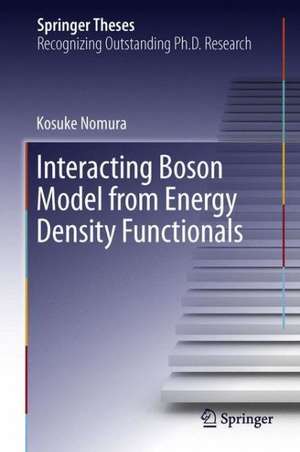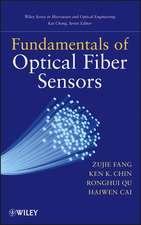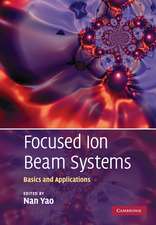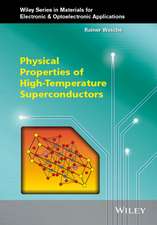Interacting Boson Model from Energy Density Functionals: Springer Theses
Autor Kosuke Nomuraen Limba Engleză Hardback – 9 feb 2013
| Toate formatele și edițiile | Preț | Express |
|---|---|---|
| Paperback (1) | 611.27 lei 6-8 săpt. | |
| Springer – 7 mar 2015 | 611.27 lei 6-8 săpt. | |
| Hardback (1) | 616.15 lei 6-8 săpt. | |
| Springer – 9 feb 2013 | 616.15 lei 6-8 săpt. |
Din seria Springer Theses
- 15%
 Preț: 614.60 lei
Preț: 614.60 lei - 15%
 Preț: 611.89 lei
Preț: 611.89 lei - 15%
 Preț: 616.15 lei
Preț: 616.15 lei - 18%
 Preț: 1172.17 lei
Preț: 1172.17 lei - 15%
 Preț: 617.89 lei
Preț: 617.89 lei - 18%
 Preț: 960.54 lei
Preț: 960.54 lei - 18%
 Preț: 1169.91 lei
Preț: 1169.91 lei - 15%
 Preț: 615.35 lei
Preț: 615.35 lei -
 Preț: 370.62 lei
Preț: 370.62 lei - 15%
 Preț: 616.15 lei
Preț: 616.15 lei - 18%
 Preț: 1067.54 lei
Preț: 1067.54 lei - 15%
 Preț: 611.27 lei
Preț: 611.27 lei - 18%
 Preț: 749.08 lei
Preț: 749.08 lei - 18%
 Preț: 1068.71 lei
Preț: 1068.71 lei - 18%
 Preț: 960.76 lei
Preț: 960.76 lei - 18%
 Preț: 959.13 lei
Preț: 959.13 lei - 15%
 Preț: 615.35 lei
Preț: 615.35 lei - 15%
 Preț: 612.23 lei
Preț: 612.23 lei - 18%
 Preț: 906.80 lei
Preț: 906.80 lei -
 Preț: 374.91 lei
Preț: 374.91 lei -
 Preț: 375.07 lei
Preț: 375.07 lei - 15%
 Preț: 618.34 lei
Preț: 618.34 lei -
 Preț: 372.50 lei
Preț: 372.50 lei - 15%
 Preț: 613.31 lei
Preț: 613.31 lei - 15%
 Preț: 617.08 lei
Preț: 617.08 lei - 18%
 Preț: 1060.72 lei
Preț: 1060.72 lei - 20%
 Preț: 596.27 lei
Preț: 596.27 lei - 18%
 Preț: 909.08 lei
Preț: 909.08 lei - 18%
 Preț: 1067.54 lei
Preț: 1067.54 lei - 18%
 Preț: 1065.27 lei
Preț: 1065.27 lei - 18%
 Preț: 1336.71 lei
Preț: 1336.71 lei - 18%
 Preț: 1064.50 lei
Preț: 1064.50 lei - 18%
 Preț: 1061.89 lei
Preț: 1061.89 lei - 18%
 Preț: 961.40 lei
Preț: 961.40 lei - 18%
 Preț: 908.31 lei
Preț: 908.31 lei - 15%
 Preț: 615.35 lei
Preț: 615.35 lei - 18%
 Preț: 962.00 lei
Preț: 962.00 lei - 18%
 Preț: 1172.94 lei
Preț: 1172.94 lei - 15%
 Preț: 615.35 lei
Preț: 615.35 lei - 15%
 Preț: 611.43 lei
Preț: 611.43 lei - 18%
 Preț: 1329.13 lei
Preț: 1329.13 lei -
 Preț: 378.41 lei
Preț: 378.41 lei -
 Preț: 372.31 lei
Preț: 372.31 lei - 18%
 Preț: 853.71 lei
Preț: 853.71 lei - 18%
 Preț: 966.67 lei
Preț: 966.67 lei - 15%
 Preț: 621.97 lei
Preț: 621.97 lei - 15%
 Preț: 612.55 lei
Preț: 612.55 lei - 20%
 Preț: 599.34 lei
Preț: 599.34 lei - 20%
 Preț: 600.83 lei
Preț: 600.83 lei
Preț: 616.15 lei
Preț vechi: 724.89 lei
-15%
Puncte Express: 924
Preț estimativ în valută:
109.08€ • 127.02$ • 94.76£
109.08€ • 127.02$ • 94.76£
Carte tipărită la comandă
Livrare economică 23 februarie-09 martie
Preluare comenzi: 021 569.72.76
Specificații
ISBN-13: 9784431542339
ISBN-10: 4431542337
Pagini: 204
Ilustrații: XIII, 188 p. 106 illus., 39 illus. in color.
Dimensiuni: 155 x 235 x 17 mm
Greutate: 0.43 kg
Ediția:2013
Editura: Springer
Colecția Springer
Seria Springer Theses
Locul publicării:Tokyo, Japan
ISBN-10: 4431542337
Pagini: 204
Ilustrații: XIII, 188 p. 106 illus., 39 illus. in color.
Dimensiuni: 155 x 235 x 17 mm
Greutate: 0.43 kg
Ediția:2013
Editura: Springer
Colecția Springer
Seria Springer Theses
Locul publicării:Tokyo, Japan
Public țintă
ResearchCuprins
Basic Notions.- Rotating Deformed Systems with Axial Symmetry.- Weakly Deformed Systems with Triaxial Dynamics.- Comparison with Geometrical Model.- Is axially Asymmetric Nucleus Gamma Rigid or Unstable?.- Ground-state Correlation.- Summary and Concluding Remarks.
Notă biografică
Dr. Kosuke Nomura
Institut für KernphysikUniversität zu Köln
Köln
Germany
(Current address)
Institut für KernphysikUniversität zu Köln
Köln
Germany
(Current address)
Textul de pe ultima copertă
This thesis describes a novel and robust way of deriving a Hamiltonian of the interacting boson model based on microscopic nuclear energy density functional theory. Based on the fact that the multi-nucleon induced surface deformation of finite nucleus can be simulated by effective boson degrees of freedom, intrinsic properties of the nucleon system, obtained from self-consistent mean-field method with a microscopic energy density functional, are mapped onto the boson analog. Thereby, the excitation spectra and the transition rates for the relevant collective states having good symmetry quantum numbers are calculated by the subsequent diagonalization of the mapped boson Hamiltonian. Because the density functional approach gives an accurate global description of nuclear bulk properties, the interacting boson model is derived for various situations of nuclear shape phenomena, including those of the exotic nuclei investigated at rare-isotope beam facilities around the world. This work provides, for the first time, crucial pieces of information about how the interacting boson model is justified and derived from nucleon degrees of freedom in a comprehensive manner.
Caracteristici
Bridges the gap between the nuclear energy density functional theory and the interacting boson model, thereby providing a possible microscopic origin of the interacting boson model from nucleon degrees of freedom Points to a universal microscopic description of low-energy collective phenomena in finite nucleus including those of the exotic nuclei under extreme conditions Nominated as an outstanding contribution by the University of Tokyo's Physics Department in 2011 Includes supplementary material: sn.pub/extras







